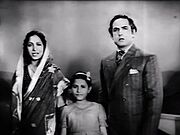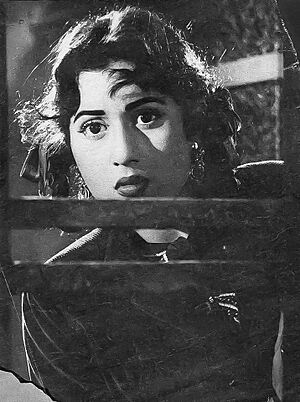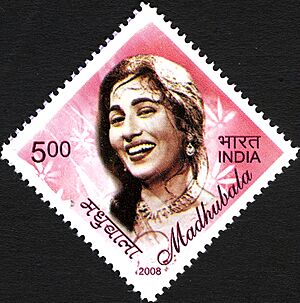Madhubala facts for kids
Quick facts for kids
Madhubala
|
|
|---|---|
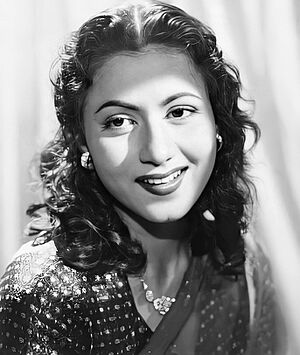
Madhubala, c. 1951
|
|
| Born |
Mumtaz Jehan Begum Dehlavi
14 February 1933 |
| Died | 23 February 1969 (aged 36) Bombay, Maharashtra, India
|
| Cause of death | Ventricular septal defect |
| Resting place | Juhu Muslim Cemetery, Santa Cruz, Mumbai |
| Occupation | Actress |
| Years active | 1942–1964 |
|
Works
|
Full list |
| Spouse(s) | |
| Relatives | Ganguly family (by marriage) |
Madhubala (born Mumtaz Jehan Begum Dehlavi; February 14, 1933 – February 23, 1969) was a famous Indian actress. She starred in many Hindi-language films. Madhubala is known as one of the greatest actresses in Indian cinema history. In the early 1950s, she was the highest-paid Indian star. She acted in over 60 films during her career, which lasted more than 20 years.
Madhubala grew up in Delhi. When she was 8 years old, her family moved to Bombay (now Mumbai). Soon after, she started acting in small roles in movies. By the late 1940s, she began getting main roles. She became very successful with films like Neel Kamal (1947), Mahal (1949), and romantic movies like Badal (1951) and Tarana (1951). Later, she had more hits with comedies such as Mr. & Mrs. '55 (1955), Chalti Ka Naam Gaadi (1958), and Half Ticket (1962). She also starred in crime films like Howrah Bridge (1958) and Kala Pani (1958).
Her role as Anarkali in the historical film Mughal-e-Azam (1960) was very special. This movie was the biggest hit in India at that time. Her acting in it was highly praised and is still considered one of the best in Indian film history. She received her only nomination for the Filmfare Award for Best Actress for this role. In the 1960s, she acted less often. Her last film appearance was in Sharabi (1964). She also helped produce three films through her own company, Madhubala Private Ltd.
Madhubala kept her personal life private, but she was known for her charity work. She also had relationships with actors Dilip Kumar and Kishore Kumar. She married Kishore Kumar in 1960. From her early thirties, Madhubala suffered from a heart condition called ventricular septal defect. This illness caused her to have trouble breathing and cough up blood. It eventually led to her death in 1969.
Contents
Early Life and First Steps in Acting
Madhubala was born as Mumtaz Jehan Begum Dehlavi in Delhi, British India, on February 14, 1933. She was the fifth of Ataullah Khan and Aayesha Begum's eleven children. Sadly, several of her siblings died when they were babies. Her father worked for the Imperial Tobacco Company. Madhubala was born with a heart problem that had no cure at the time.
She spent most of her childhood in Delhi and seemed healthy. Her father had strict rules, so Madhubala and most of her sisters did not go to school. However, she learned Urdu, Hindi, and her native language, Pashto, from her father. She loved watching movies and would often dance and pretend to be film characters. Even though her family was traditional, she dreamed of becoming an actress, which her father did not like at first.
Her father's mind changed in 1940 after he lost his job. Madhubala's mother worried about what people would say if their daughter worked in movies. But her father was determined. Madhubala, at age seven, started singing at the All India Radio station. There, she met Rai Bahadur Chunnilal, a manager at Bombay Talkies studio in Bombay. Chunnilal liked Madhubala and told her father to move to Bombay for better job chances.
Becoming a Star
Early Roles and Big Break (1942–1947)
In 1941, Madhubala's family moved to Bombay. Chunnilal helped Madhubala get a small role in the film Basant (1942). She earned 150 rupees for this. Basant was a big hit, and Madhubala's acting was liked. However, the studio did not need a child actor anymore, so they ended her contract. Her family had to return to Delhi and faced money problems.
In 1944, Bombay Talkies called Madhubala back for a role, but she did not get it. Still, her father decided to stay in Bombay for good. Madhubala and her father visited many studios looking for work. She soon signed a three-year contract with Ranjit Movietone, earning 300 rupees a month. This income allowed her family to rent a house.
In April 1944, their rented house was destroyed in a dock explosion. Madhubala and her family were safe because they were at a movie theater. She continued acting in small roles in five films, credited as "Baby Mumtaz." These years were tough. In 1945, she coughed up blood, which was an early sign of her illness. In 1946, she had to borrow money for her mother's medical treatment. To get more adult roles, she started filming two movies, Chittor Vijay and Mere Bhagwaan, in November 1946.
Madhubala's first main role was in Neel Kamal (1947). She starred with Raj Kapoor, who was also new. The film was popular and made Madhubala well-known. She then worked with Kapoor again in other films, but they were not successful. During this time, she took lower fees to get more offers. To help her family, she quickly signed up for 24 films. The head of Bombay Talkies, Devika Rani, suggested she change her professional name from "Mumtaz" to "Madhubala."
Rising to Fame (1948–1957)
Madhubala's first big success was the drama Lal Dupatta (1948). Critics said it was a turning point for her acting. She also received good reviews for her supporting roles in other films. In 1949, Madhubala starred in Mahal, which was India's first horror film. Many actresses were considered, but the director wanted Madhubala. She played a servant girl who pretends to see ghosts. The film was made on a small budget, and many thought it would fail. But Mahal was a huge hit and became the third biggest box-office success of the year. This led to Madhubala getting many starring roles with top actors.
After another hit, Dulari (1949), Madhubala starred in Beqasoor (1950), which was also very successful. In 1950, she appeared in Hanste Aansoo, the first Indian film to be given an "Adult" rating. The next year, she starred in the action film Badal (1951), a remake of The Adventures of Robin Hood. She played a princess who falls in love with a character played by Prem Nath. Both Badal and Saiyan were big hits. Madhubala then worked with actor Dilip Kumar in Tarana (1951) and Sangdil (1952). These films also did well, and the pair became very popular.
In 1953, Madhubala started her own production company, Madhubala Private Ltd. The next year, while filming in Madras, her heart condition caused a major health problem. She returned to Bombay and took a break from work. This led to her being replaced in some films. She then starred in Amar, playing a social worker. This film did not do well at the box office. However, critics praised Madhubala's acting, calling it one of her most mature performances. Her own production, Naata (1955), which she starred in with her sister, lost a lot of money. Madhubala had to sell her house to cover the losses.
Madhubala made a strong comeback in 1955 with the comedy Mr. & Mrs. '55. This film was one of the highest-grossing films of the year and her biggest success at that time. She played a rich girl forced into a fake marriage. Critics loved her "impish charm and breezy comic timing." In 1956, Madhubala had a disagreement with director B. R. Chopra over filming locations for Naya Daur. Chopra replaced her and sued her, but he later dropped the lawsuit.
Because of the lawsuit and her health issues, Madhubala worked less in 1956 and 1957. She appeared in two historical films, Raj Hath and Shirin Farhad, both of which were successful. In 1957, she played a runaway heiress in Gateway of India, which is considered one of her best performances. She also starred in the drama Ek Saal (1957), about a love story with a sick young woman.
Mughal-e-Azam and Later Success (1958–1962)
Madhubala started 1958 with Kala Pani, playing a brave journalist. She then starred as Edna in Howrah Bridge (1958), playing an Anglo-Indian cabaret dancer. This was a new kind of role for her. Both films received good reviews and were among the top-grossing films of the year. She also had a hit with Phagun (1958). In her last film of 1958, Chalti Ka Naam Gaadi, Madhubala played a rich city woman in love with Kishore Kumar. This comedy was one of the biggest money-makers of the 1950s. Critics praised her "oodles of charisma" and "infectious giggles."
Her film Insan Jaag Utha (1959) was a social drama. It was a modest success, and her performance as a village girl was later called one of her finest. In 1959, she also played two roles in Kal Hamara Hai. The author of a book about her called it "a polished performance." The film Do Ustad (1959) with Raj Kapoor was also a commercial success. However, her company's second film, Mehlon Ke Khwab (1960), did not do well.
Journalists have called Mughal-e-Azam (1960) the "crowning glory" of Madhubala's career. She starred with Dilip Kumar and Prithviraj Kapoor. The film is about a 16th-century court dancer, Anarkali (Madhubala), and her love for the Mughal prince Salim (Kumar). Madhubala joined the cast in 1952 and received a very high payment for an actress at that time. Filming was very difficult. Her relationship with Dilip Kumar ended during the shoot, and there were reports of tension between them. Madhubala also struggled with night filming and difficult dance scenes, which her doctors had told her to avoid. She had to perform challenging scenes, like falling under heavy chains and putting out candles with her hand. The filming of Mughal-e-Azam took ten years and left her very tired.
Mughal-e-Azam was one of Madhubala's two films shot in color. It was released on August 5, 1960, and broke box office records, becoming the highest-grossing Indian film ever for 15 years. It won the National Film Award for Best Feature Film in Hindi and received 11 nominations at the 8th Filmfare Awards, including Best Actress for Madhubala. Critics praised her acting, saying she showed Anarkali's changing moods "superb[ly]."
After Mughal-e-Azam's success, Madhubala received many offers. But she had to turn them down because of her heart condition. She also had to leave some films that were already being made. However, she did have a few more releases that were finished with the help of body doubles or by Madhubala herself. In late 1960, she appeared in the crime film Jaali Note, which was a financial success. Her role in the musical Barsaat Ki Raat (1960) was better received. This film was the second-highest-grossing film of the year, after Mughal-e-Azam.
The huge success of Mughal-e-Azam and Barsaat Ki Raat made Madhubala the most successful leading actress of 1960. After this, she acted less often, mostly in comedies like Jhumroo (1961), Boy Friend (1961), and Half Ticket (1962). All three of her 1961 films were among the top-grossing movies of the year. Half Ticket, her last film with her husband Kishore Kumar, was also a big hit. Critics loved the "palpably fond chemistry" between them. In 1962, Madhubala Private Ltd.'s third film, Pathan, was a box office failure.
Final Years and Last Work (1964–1969)
After a two-year break, Madhubala finished Sharabi in 1964. This film would be her last release during her lifetime. Critics praised her performance. An editor called Sharabi "a fitting finale to a luminous career."
Two years after Madhubala's death, one of her unfinished films, Jwala (1971), was released. Most of the film was completed using body doubles. It was her final screen role.
Personal Life
Madhubala grew up in a traditional family and was very religious. After becoming financially stable in the late 1940s, she rented a large house in Bombay called "Arabian Villa," which became her home until she died. She learned to drive at 12 and later owned five cars. She learned English in three months in 1950 and also kept eighteen Alsatian dogs.
In mid-1950, doctors found that Madhubala had an incurable ventricular septal defect in her heart. This news was kept private to protect her career.
Relationships and Marriage
Madhubala's first relationship was with her Badal co-star Prem Nath in 1951. They dated for six months, but their different religions caused them to break up. However, Nath remained close to Madhubala and her father. Also in 1951, Madhubala began a romance with actor Dilip Kumar. Their relationship received a lot of media attention. Friends said these years were the happiest of her life.
Madhubala and Dilip got engaged, but they could not marry because her father had objections. He wanted Dilip to act in his production company's films, which Dilip refused. Also, Dilip wanted Madhubala to cut ties with her family if they married. They broke up in 1957 during a court case over the film Naya Daur. Dilip testified against her and her father, which deeply upset Madhubala. Around this time, three other co-stars proposed marriage to her: Bharat Bhushan, Pradeep Kumar, and Kishore Kumar.
On the set of Chalti Ka Naam Gaadi (1958), Madhubala became close again with Kishore Kumar, whom she had known since childhood. They dated for two years and had a court marriage on October 16, 1960. There were rumors that Kishore Kumar changed his religion to marry her, but her sister has said this is not true. Her father and Kishore's family did not like the marriage. People in the film industry also thought they were an odd match because of their different personalities.
Health Problems and Last Days
"[I] brought her home as my wife, even though I knew she was dying from a congenital heart problem. For 9 long years, I nursed her. I watched her die before my own eyes. You can never understand what this means until you live through this yourself. She was such a beautiful woman and she died so painfully. She would rave and rant and scream in frustration. How can such an active person spend 9 long years bed-ridden? And I had to humour her all the time. That's what the doctor asked me to. That's what I did till her very last breath. I would laugh with her. I would cry with her."
Soon after their marriage in 1960, Madhubala and Kishore Kumar went to London for her honeymoon and for special treatment for her heart disease, which was getting worse. In London, doctors said they could not operate on her. They advised her to avoid stress and not have children. They told her she might only live for two more years.
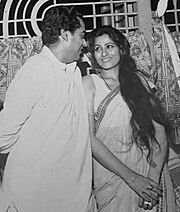
Madhubala and Kishore returned to Bombay, and she moved into Kishore's home. Her health continued to decline, and she often argued with her husband. Kishore's brother, Ashok Kumar, said her illness made her "bad-tempered." She spent most of her time at her father's house. To avoid family tensions, Madhubala later moved into Kishore's new apartment. However, Kishore stayed there only for a short time and then left her with a nurse and driver. Even though he paid for her medical care, Madhubala felt alone and returned to her own house within two months of her marriage. For the rest of her life, he visited her sometimes. Her sister thought he might have been trying to prepare himself for their eventual separation.
In mid-1966, Madhubala seemed a little better and decided to return to acting with a film called Chalaak. But she fainted as soon as filming began, and the movie was never finished. She was then hospitalized. To help her sleep, she tried hypnosis, but it made her problems worse.
Madhubala spent her last years mostly in bed and lost a lot of weight. She loved Urdu poetry and often watched her own films, especially Mughal-e-Azam, on a home projector. She became very private, only meeting a few people from the film industry. She needed frequent blood transfusions. Her body produced too much blood, which would come out of her nose and mouth. Doctors had to remove the blood, and she often needed an oxygen tank because she had low oxygen levels. After the Chalaak incident, Madhubala wanted to direct films and began preparing for her first movie as a director in February 1969.
Death
By early 1969, Madhubala's health was very bad. Madhubala had a heart attack on the night of February 22. She passed away at 9:30 a.m. on February 23, 1969, just nine days after her 36th birthday. Madhubala was buried at Juhu Muslim Cemetery in Santacruz, Bombay. Her tomb had marble and verses from the Quran.
Because Madhubala had been out of the public eye for almost ten years, her death was a surprise. It was widely reported in the Indian press. The Indian Express called her "the most sought-after Hindi film actress" of her time. Many of her co-workers expressed their sadness. In 2010, Madhubala's tomb was removed to make space for new graves, and her remains were moved to an unknown place.
Legacy and Tributes
Legacy
Madhubala's legacy continues to be loved by fans of all ages. Even people who don't know much about old movies recognize her. She has many fan sites on social media. Magazines still write about her life and career, often putting her on their covers. She is also known for creating fashion trends, like wavy hairstyles and strapless dresses, which many celebrities still follow. News 18 said, "the cult of Madhubala is a difficult thing to match up to." Many modern celebrities, like Aamir Khan, Hrithik Roshan, and Shah Rukh Khan, say Madhubala is one of their favorite Indian film artists.
A research analyst named Rohit Sharma studied why Madhubala is still popular today. On her 85th birthday, the Hindustan Times called Madhubala "by far, the most iconic silver screen goddess India has produced." After her death, she became one of the most celebrated people in Indian cinema. She is often called one of India's finest and most beautiful actresses ever. Books have also been written about her.
Works and Awards
Madhubala acted in 72 films between 1942 and 1964. Some of her famous films include Basant (1942), Neel Kamal (1947), Mahal (1949), Badal (1951), Tarana (1951), Amar (1954), Mr. & Mrs. '55 (1955), Kala Pani (1958), Howrah Bridge (1958), Chalti Ka Naam Gaadi (1958), Mughal-e-Azam (1960), Barsaat Ki Raat (1960), Half Ticket (1962), and Sharabi (1964). Her 73rd and last film, Jwala (1971), was released after her death. She was also a producer for Naata (1955), Mehlon Ke Khwab (1960), and Pathan (1962). For her role in Mughal-e-Azam, Madhubala was nominated for the Filmfare Award for Best Actress. This was her only award nomination.
Tributes and Honors
In 2004, a Greek song called Mandoubala, dedicated to her, was performed at the closing ceremony of the Athens Olympics. Two of Madhubala's films, Mughal-e-Azam (in 2004) and Half Ticket (in 2012), were digitally colorized and re-released in theaters. In March 2008, India Post released a special postage stamp featuring Madhubala. Her family and co-stars launched it. At that time, only one other Indian actress, Nargis, had been honored this way.
In 2010, Filmfare magazine listed Madhubala's performance as Anarkali in Mughal-e-Azam as one of Bollywood's "80 Iconic Performances." Her introduction scene in Mughal-e-Azam was also listed as one of "20 scenes that took our breath away." The film itself is considered one of the greatest films ever made. In August 2017, Madame Tussauds Delhi unveiled a wax statue of Madhubala, inspired by her look in Mughal-e-Azam. In 2018, The New York Times published a belated obituary for Madhubala, comparing her life to that of Marilyn Monroe. On February 14, 2019, her 86th birthday, Google honored her with a doodle. Google said: "While her breathtaking appearance earned comparisons to Venus, Madhubala was a gifted actor with an understated style well suited for comedies, dramas, and romantic roles alike. [...] Appearing in over 70 films over the course of a tragically brief career, Madhubala—who would have turned 86 today—was called "The Biggest Star in the World" in 1952 by Theatre Arts Magazine."


